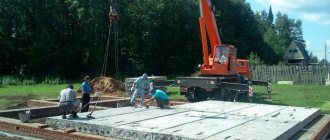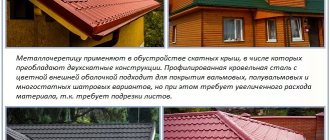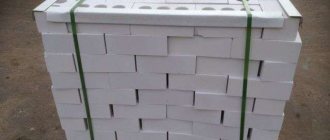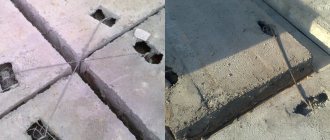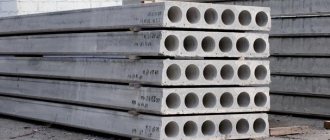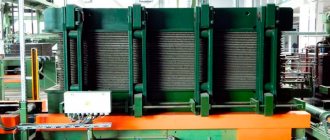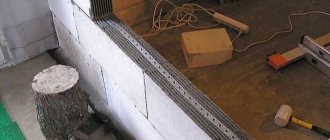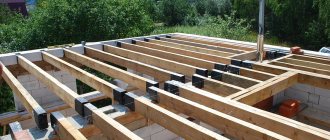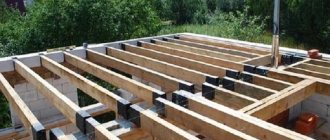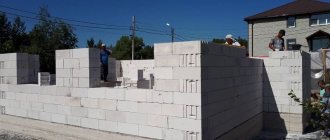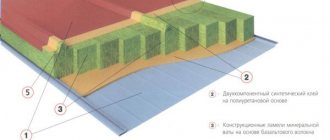In buildings and structures of any type and purpose, reinforced concrete floor slabs are used as load-bearing structures separating floors. The main determining parameter for choosing products is the size in length and width.
Enterprises producing reinforced concrete products offer floor slabs in a wide range of linear dimensions, but no less important criteria are the structural and technical and operational characteristics of the slabs.
Main types
Floor slabs of all types are products made of structural concrete with mandatory reinforcement with steel reinforcement or mesh.
Table 1 . Main types of floor slabs
| № | Marking | Design | Peculiarities |
| 1 | P | Full-bodied, monolithic | High strength, heavy weight |
| 2 | PT | Monolithic, solid | High strength, heavy weight |
| 3 | PC | Void | Manufactured using formwork |
| 4 | PB | Void | Manufactured without formwork |
| 5 | NV | Void | Produced by steaming in metal molds |
| 6 | 2PB | Void thickened | Manufactured without formwork, the thickness is increased |
| 7 | PNO | Void | Manufactured using formwork, thickness reduced |
| 8 | 3.1PB | Void | Manufactured without formwork, thickness reduced |
| 9 | 1.6PB | Void | Manufactured without formwork, thickness reduced |
| 10 | PG | Ribbed | Resistant to seismic and vibration loads |
| 11 | ETC | Ribbed | Resistant to seismic and vibration loads |
| 12 | PP | Ribbed | Resistant to seismic and vibration loads |
The table lists only the main, most common series of reinforced concrete floors in our country. Designers are constantly developing new models and modifying old series, as the development of the reinforced concrete industry is dynamic, new materials and technologies are being introduced. But the vast majority of manufacturers work using standard, proven technological solutions, especially in the low-rise housing construction segment.
Hollow core slabs
Today there are many options available for the manufacture or installation of floors and coverings, most of them are based on the use of precast reinforced concrete hollow slabs.
The only condition for independently choosing products for flooring: a detailed study of the characteristics and dimensions of the slabs.
The PC and PB series slabs differ in production technology, but have the same standard thickness of 220 mm.
PCs (as well as PNO) are manufactured using formwork for each product. A reinforcing frame is installed into it, then the product is compacted using vibration equipment. This is a traditional technology that makes it difficult to make critical errors during manufacturing. Sometimes the developer needs information on the number of possible sides for supporting a slab. For this purpose, there is a clarification in the marking of PC slabs: a product designated PKT can rest on 3 sides, and PKK - on four.
PB products (as well as 2PB, 3.1PB, 1.6PB) are poured with concrete mixture on a continuously moving conveyor. After hardening, the semi-finished slab is cut into slabs of the required length. This is a formless technology.
Important! The products do not have transverse reinforcement, which allows them to be cut without loss of strength. Not only transverse, but also longitudinal cutting of the slab is possible, as well as at an angle of 45 degrees. This possibility should be taken into account by developers who need to cut off part of the slab during the installation process - such actions are undesirable with slabs of other brands.
Formless products have more precise geometry and a smooth surface.
PNO, 3.1PB and 1.6PB slabs are made from heavy concrete. Their main difference from PB and PC is their reduced thickness - 160 mm.
2PB products have a thickness of 265 mm.
Solid slabs
Precast concrete products of the PT and P type are in little demand among developers of individual residential buildings. These slabs are in demand in the construction of various tray-type tunnels, chambers, channels, including those under roads and railways.
PT and P slabs do not have technological voids, have high rigidity, and the thickness reaches 160 and 120 mm, respectively.
Ribbed slabs
PR floors are universal, but, as a rule, they are used in the construction of large industrial and commercial facilities.
GHGs are used to cover structures - like the roof of non-attic buildings.
The height of slabs of this type is measured by stiffening ribs arranged along the products. It is 300 or 400 mm, on the horizontal plane - no less than 50 mm.
Types and sizes of hollow-core slabs
A multi-hollow slab is a reinforced concrete structure, inside of which there are voids located at a certain pitch, obtained by immersing punches (void formers) into the thickness of the concrete. The most commonly used in construction are hollow-core type floor slabs such as PC, PB and PNO. Compared to monolithic and solid products, hollow products have a number of advantages.
With relatively similar strength characteristics, they benefit due to:
- less weight, which helps reduce loads on supporting structures;
- high accuracy of dimensional parameters (especially good performance for PB type slabs);
- the ability to choose a product of suitable length and width, application regardless of climatic conditions;
- the presence of voids filled with air, contributing to good heat and sound insulation;
- the possibility of hidden placement of pipes, cables and other elements of engineering communications in voids;
- lack of a waiting period when installing structures (compared to monolithic ones, which require 28 days for concrete to gain strength).
Plates – 1pc and 2pc
Description
PC slabs are rectangular-shaped products with round voids and reinforcement elements located inside.
Inside these reinforced concrete products there is a frame made of stressed steel reinforcement.
- 1 PC slabs have a thickness of 220 mm, the diameter of the cylindrical recesses is 159 mm.
- 2 PC slabs have the same thickness, but a slightly smaller diameter of the voids - 140 mm.
PC plate.
Manufacturing technology
For the manufacture of multi-hollow reinforced concrete structures of the PC type, formwork technology is used. The formwork, in which the reinforcement is pre-laid and has the appearance of a special shape, is filled with mortar. Next, the concrete is compacted using special equipment that creates vibrations of the required strength and frequency.
This method makes it possible to obtain products with voids of different diameters (max. 159 mm), necessary to reduce the weight of the slab.
Mold for the production of PC board.
Purpose
PC series products are used year-round in multi-storey industrial and residential construction. Conditions for installation: absence of aggressive environment, normal humidity and temperature.
Round holes in the plates allow elements of the life support system to be installed compactly and hidden inside. It is possible to lay these slabs during the construction of a multi-storey private house. In this case, the building design must necessarily include a reinforcing belt.
Other applications:
- arrangement of pitched roofs of sheds, garages and other buildings;
- laying the foundation for installing gazebos and continuous fences.
Installation of PC board.
Marking
All the information the developer needs is contained in the slab markings.
Marking example: PC 60-12-8
Explanation of markings:
- PC - round hollow-core floor slab. Manufactured using formwork using a mold and steaming procedure.
- The number 60 is the length of the structure in decimeters rounded to the nearest whole, which is 6 meters. In this case, differences of several mm in each direction are not taken into account.
- Digital index 12 indicates that the width of the slab is 1 meter 20 cm (also measured in decimeters).
- The last figure reflects the permissible load, measured in Megapascals. In the example, the number 8 indicates the maximum load limit of 800 kgf/m.
Dimensions
The range of PC slabs of standard sizes with the corresponding characteristics is presented in the table below.
Table 1. Dimensions of PC floor slabs
| Slab size | Coordination dimensions of the slab, mm | Slab weight (reference), t | |
| Length L0 | Width b0 | ||
| Plates types 1pk, 2pk | |||
| 1PC 24.10 | 2400 | 1000 | 0,8 |
| 1PC 24.12 | 1200 | 0,9 | |
| 1pc 24.15 | 1500 | 1.1 | |
| 1PC 24.18 | 1800 | 1.3 | |
| 1pc 24.24 | 2400 | 1.8 | |
| 1 pc 24.30 | 3000 | 2.2 | |
| 1pc 24.36 | 3600 | 2.7 | |
| 1PC 27.10 | 2700 | 1000 | 0.9 |
| 1PC 27.12 | 1200 | 1.0 | |
| 1PC 27.15 | 1500 | 1.2 | |
| 1PC 27.18 | 1800 | 1.4 | |
| 1pc 27.24 | 2400 | 2.0 | |
| 1 PC 27.30 | 3000 | 2.4 | |
| 1pc 27.36 | 3600 | 3.0 | |
| 1pk 30.10 | 3000 | 1000 | 0.9 |
| 1pk 30.12 | 1200 | 1.1 | |
| 1pc 30.15 | 1500 | 1.4 | |
| 1pc 30.18 | 1800 | 1.7 | |
| 1pc 30.24 | 2400 | 2.2 | |
| 1pc 30.30 | 3000 | 2.8 | |
| 1PC 33.10 | 3300 | 1000 | 1.0 |
| 1PC 33.12 | 1200 | 1.2 | |
| 1pc 33.15 | 1500 | 1.5 | |
| 1pc 33.18 | 1800 | 1.8 | |
| 1pc 33.24 | 2400 | 2.4 | |
| 1pc 33.30 | 3000 | 3.0 | |
| 1pc 33.36 | 3600 | 3.6 | |
| 1PC 36.10 | 3600 | 1000 | 1.1 |
| 1PC 36.12 | 1200 | 1.3 | |
| 1pc 36.15 | 1500 | 1.7 | |
| 1pc 36.18 | 1800 | 2.0 | |
| 1pc 36.24 | 2400 | 2.7 | |
| 1pc 36.30 | 3000 | 3.3 | |
| 1pc 36.36 | 3600 | 4.0 | |
| 1PC 39.10 | 3900 | 1000 | 1.2 |
| 1PC 39.12 | 1200 | 1.4 | |
| 1pk 39.15 | 1500 | 1.8 | |
| 1PC 39.18 | 1800 | 2.1 | |
| 1pc 39.24 | 2400 | 2.9 | |
| 1pk 39.30 | 3000 | 3.5 | |
| 1pc 39.36 | 3600 | 4.3 | |
| 1PC 42.10 | 4200 | 1000 | 1.3 |
| 1PC 42.12 | 1200 | 1.6 | |
| 1pc 42.15 | 1500 | 2.0 | |
| 1pc 42.18 | 1800 | 2.3 | |
| 1pc 42.24 | 2400 | 3.1 | |
| 1pc 42.30 | 3000 | 3.9 | |
| 1pc 42.36 | 3600 | 4.7 | |
| 1pk 45.10 | 4500 | 1000 | 1.4 |
| 1pk 45.12 | 1200 | 1.7 | |
| 1pc 45.15 | 1500 | 2.1 | |
| 1pc 45.18 | 1800 | 2.4 | |
| 1pc 45.24 | 2400 | 3.3 | |
| 1pc 45.30 | 3000 | 4.1 | |
| 1pc 45.36 | 3600 | 5.0 | |
| 1PC 48.10 | 4800 | 1000 | 1.5 |
| 1PC 48.12 | 1200 | 1.8 | |
| 1pc 48.15 | 1500 | 2.2 | |
| 1pc 48.18 | 1800 | 2.7 | |
| 1pc 48.24 | 2400 | 3.6 | |
| 1pc 48.30 | 3000 | 4.5 | |
| 1pc 48.36 | 3600 | 5.4 | |
| 1pk 51.10 | 5100 | 1000 | 1.6 |
| 1PC 51.12 | 1200 | 1.9 | |
| 1pc 51.15 | 1500 | 2.4 | |
| 1pc 51.18 | 1800 | 2.9 | |
| 1pc 51.24 | 2400 | 3.8 | |
| 1pc 51.30 | 3000 | 4.8 | |
| 1pc 51.36 | 3600 | 5.7 | |
| 1PC 54.10 | 5400 | 1000 | 1.7 |
| 1PC 54.12 | 1200 | 2.0 | |
| 1pc 54.15 | 1500 | 2.5 | |
| 1pc 54.18 | 1800 | 3.0 | |
| 1pc 54.24 | 2400 | 4.0 | |
| 1pc 54.30 | 3000 | 5.0 | |
| 1pc 54.36 | 3600 | 6.0 | |
| 1PC 57.10 | 5700 | 1000 | 1.8 |
| 1PC 57.12 | 1200 | 2.1 | |
| 1pc 57.15 | 1500 | 2.6 | |
| 1pk 57.18 | 1800 | 3.1 | |
| 1pc 57.24 | 2400 | 4.2 | |
| 1pc 57.30 | 3000 | 5.2 | |
| 1pc 57.36 | 3600 | 6.3 | |
| 1pc 60.10 | 6000 | 1000 | 1.9 |
| 1pk 60.12 | 1200 | 2.2 | |
| 1pc 60.15 | 1500 | 2.8 | |
| 1pc 60.18 | 1800 | 3.3 | |
| 1pc 60.24 | 2400 | 4.5 | |
| 1pc 60.30 | 3000 | 5.6 | |
| 1pc 60.36 | 3600 | 6.7 | |
| 1PC 63.10 | 6300 | 1000 | 2.0 |
| 1PC 63.12 | 1200 | 2.4 | |
| 1pc 63.15 | 1500 | 3.0 | |
| 1pc 63.18 | 1800 | 3.5 | |
| 1pc 63.24 | 2400 | 4.7 | |
| 1pc 63.30 | 3000 | 5.9 | |
| 1pc 63.36 | 3600 | 7.1 | |
| 1PC 66.10 | 6600 | 1000 | 2.1 |
| 1PC 66.12 | 1200 | 2.5 | |
| 1pc 66.15 | 1500 | 3.1 | |
| 1pc 66.18 | 1800 | 3.7 | |
| 1pc 66.24 | 2400 | 5.0 | |
| 1pc 66.30 | 3000 | 6.2 | |
| 1pc 66.36 | 3600 | 7.4 | |
| 1pk 72.10 | 7200 | 1000 | 2.3 |
| 1PC 72.12 | 1200 | 2.7 | |
| 1pc 72.15 | 1500 | 3.3 | |
| 1pc 72.18 | 1800 | 4.0 | |
| 1pc 72.24 | 2400 | 5.4 | |
| 1pc 72.30 | 3000 | 6.7 | |
| 1pc 72.36 | 3600 | 8.1 | |
| 1pc 75.10 | 7500 | 1000 | 2.4 |
| 1pk 75.12 | 1200 | 2.8 | |
| 1pc 75.15 | 1500 | 3.4 | |
| 1pc 75.18 | 1800 | 4.1 | |
| 1pc 75.24 | 2400 | 5.6 | |
| 1pc 75.30 | 3000 | 6.9 | |
| 1pc 75.36 | 3600 | 8.4 | |
| 1pc 90.10 | 9000 | 1000 | 2.8 |
| 1PC 90.12 | 1200 | 3.3 | |
| 1pc 90.15 | 1500 | 4.1 | |
Note: To find out the data for products of type 2 PC, you must put 2 in the marking instead of 1.
Plates - PB
Description
This type of slab is a new generation material that is superior in geometry accuracy and characteristics to PC type slabs. Slabs of this type are produced by formless molding, and the basis for the hollow-core PB slab is heavy concrete with a joint strength index of at least B30.
To impart rigidity and strength characteristics to the structure, it is reinforced with prestressed reinforcement. Reinforcement allows installation of the slab in bending and protects the reinforced concrete structure from cracking.
Plitp PB.
The advantages of this type of product include:
- precisely maintained dimensional parameters;
- the ability to produce slabs of any length;
- the presence of recessed grooves on the side faces;
- manufacturing in accordance with reinforcement standards that provide for anti-corrosion treatment;
- evenly distributed along the entire length of the void.
Manufacturing technology
The slabs are formed by loading concrete into special conveyor-type vibration installations. This technology allows you to cut the finished reinforced concrete layer to the required length using special equipment. The method makes it possible to obtain products of increased length in standard sizes and to produce non-standard products to order.
Production of PB boards.
Russian manufacturing enterprises use three options for formless production of slabs.
As a percentage of the total volume of PB slabs produced, it is:
- 72% – for vibration shaping in one step;
- 14% – for production by extrusion;
- 13% – for two-layer splitforming.
The predominant share is given to vibration forming in one step, since this method is by far the most economical.
Purpose
Hollow-core PB slabs are in demand in the construction of large-area facilities.
Construction sites where PB products are used:
- entertainment and shopping centers;
- multi-story houses;
- private cottages and buildings;
- garages and warehouses;
- various buildings of I and II fire resistance classes.
Reinforced concrete products produced using the formless method can be laid on brick walls, load-bearing structures made of aerated concrete blocks, expanded clay concrete, and FBS. In this case, the design must necessarily provide for the presence of a reinforcing belt, which allows for a more even distribution of the load along the perimeter.
Installation of PB plate.
Marking
The marking reflects the type of plate and dimensional characteristics.
Marking example: PB 70-10-14
Explanation:
- PB - hollow slab made by formless molding;
- 70 — length in decimeters;
- 10 - width in decimeters;
- 14 - maximum load per 1 m2, expressed in kilograms, in this case it is 1400 kg.
Dimensions
The dimensions of products of this type in terms of thickness and width are determined by technical standards and are:
- thickness 220 mm;
- width 1200 mm.
If necessary, it is possible to produce slabs with a width of 1000 and 1500 mm.
Length dimensions can vary from 1 to 10.8 meters.
Explanation of markings
The main parameters of the product are applied by the manufacturer to the side surface of the slab using an alphanumeric code. Full product markings must be displayed in the quality certificate for the product provided by the manufacturer. The consumer can independently decipher the marking using the following examples:
- PC 72-12-8- AtVt: P – hollow slab; K – voids are round in cross-section; 72 – product length in decimeters (7.2 m); 12 – product width in decimeters (1.2 m); 8 — permissible load in kPa (800 kgf/m²); AtV - the class of reinforcement used in the product; t – heavy concrete was used in the production of the slab.
Marking of slabs - PB 75-12-16 : P – hollow slab; B – made by formless molding; 75 – length in decimeters (7.5 m); 12 – width in decimeters (1.2 m); 16 – permissible load in kPa (1600 kg/m²).
- 2PG-60-4-AtVt : 2PG - ribbed slab with a height of 300 mm; 60 – length in decimeters (6m); 4 – load-bearing capacity in kPa (400 kg/m²); AtV – class of fittings; t - heavy concrete was used in the production of the slab.
- P-60-12-3.5 : P – solid section slab; 60 – length in decimeters (6m); 12 – width in decimeters (1.2 m); 3.5 – concrete strength corresponds to class B3.5.
Dimensions and weight of slabs
To calculate the layout of the slabs, the developer needs to know their geometric parameters in advance. Knowing the weight of the products will help you correctly calculate the load on the load-bearing supports.
Table 2 . Dimensions and weight of hollow core slabs
| № | Stove brand | Length in mm | Width in mm | Weight in kg/m² |
| 1 | PC | 1600-6600 with an interval of 300mm, 7200, 7500 | 1000, 1200, 1500, 1800 | 280-310 |
| 2 | PB | 1600-10800 Length pitch – 300 mm To order, slabs are produced up to a maximum length of 11700 | 1000, 1200, 1500 | 300-330 |
| 3 | 3.1PB; 1.6PB | 1600-9000 Length pitch – 300 mm | 1000, 1200, 1500 | 220-240 |
| 4 | PNO | 1600-6300 Length pitch – 300 mm | 1000, 1200, 1500 | 210-230 |
Notes on the table:
1) the optimal width of the slabs for transportation is 1.2 m; in the body of a car with a standard width of 2.6 m there are 2 slabs in width.
2) manufacturers of PB boards offer services for cutting products to lengths determined by the customer; the cut can be made at any angle.
Calculation of the number of slabs and their sizes for a private house
The dimensions of the slabs and the layout of their layout on the floor are usually determined in the house construction project. But in Russian private housing construction, any miracles are possible. Often, under the slogan of saving, somewhere on the Internet, a house project is sought or the most inexpensive project is ordered. It is dangerous to build according to such sources, so the developer has to deal with the slabs during construction. But this is not scary if you approach the solution of the problem responsibly, understanding the main points - the need and dimensions of floor slabs:
The length of the slabs is the distance between the supporting walls plus the distance required to securely support the slabs on the load-bearing walls.
The width of the slabs is selected so as to completely cover the structure. During new construction, walls are built taking into account the size of the floor slabs. Products are laid closely, flush against the walls, without leaning on them. Non-load-bearing (interior) partitions are not taken into account in the calculations: the slabs are laid on top without support or against the partitions.
If it is impossible to provide complete overlap, the remaining area is poured with monolithic concrete with reinforcement into the prepared formwork. It is better to add the missing part of the ceiling with a monolith than to cover it with a “reserve” and then cut off the excess. You cannot cut factory-made stressed slabs yourself without a professional understanding of the process.
Important! In cases where the supporting load-bearing walls are made of block porous materials (aerated concrete, foam concrete, expanded clay concrete, wood concrete and others), an armored belt is installed along the walls. Reinforced concrete floor slabs are installed only after the reinforced belt concrete has completely set.
Dimensions of floor slabs: features of the use of structures
Floor slabs are horizontal panels installed between floors. In one of the articles we talked about hollow PC slabs, their sizes and features. In this article we will talk about floor slabs , what concrete slabs are. Differences between PB (PPS) and PC (PNO) floor slabs: sizes, prices and other characteristics of concrete slabs.
Hollow core slab: (read more)
Interfloor slabs are used in the private construction of cottages, for multi-storey buildings, as well as for the construction of industrial buildings.
Note! Today you can purchase almost any size of floor slabs, but standard products will cost much less. The main condition when purchasing is to choose the right type and number of panels.
Floor slabs of serial sizes that must be taken into account when designing a building.
Advantages of hollow slabs
Precast concrete products for floors made with voids have a number of advantages compared to monolithic floors and solid slabs:
- Longitudinal technological voids significantly reduce the weight of the floor structure and minimize the load on the foundation of the building.
- The air in the voids acts as a natural heat insulator.
- Factory-made slabs, as a rule, have good geometry and a smooth surface, which reduces the cost of finishing work.
- Installation of the slabs is quick and easy, reducing overall construction time.
- The cost of a slab hollow-core floor is on average 30% cheaper than an identical monolithic one.
Features of production and advantages of using certain types of products
Depending on the characteristics of production, hollow-core slabs are divided into hollow-core formwork (HC), hollow-core lightweight (VLO) and hollow-core formwork-free (PB). The production process for manufacturing hollow core slabs looks like this:
- The concrete solution is poured into a prepared metal formwork with reinforcing elements and a metal mesh located inside.
- Then, under the influence of vibration, the concrete is well compacted and processed in a hydrothermal box, the temperature in which is 80 ° C, and the absolute humidity reaches 100%. Over the course of 7-12 hours, the temperature inside the box steadily decreases.
- After the mixture has completely hardened, the finished reinforced concrete slab is removed using fixed steel eyes, which facilitate the installation of the panels. At the warehouse, all slabs are marked and receive technical documentation.
As for lightweight concrete floors, they are considered a modernized version of PC slabs, which are characterized by a reduced thickness. If the standard size of reinforced concrete floor slabs is 22 cm, then the thickness of the lightweight version is only 16 cm, which, in turn, affects the final weight and volume of the product. Thus, the volume of a lightweight concrete slab 2.4x1 m will be equal to 0.38 m³, and the volume of a standard PC slab of the same size already reaches 0.52 m³, while the weight of the first slab will be 550 kg, and the second will already be 750 kg, which indicates a significant difference in weight.
Solid slabs are heavy, so the support must be much stronger than reinforced concrete.
Due to the fact that more dense reinforcement is used in the production of the slab using thicker reinforcement, it can withstand the same weight as hollow PC slabs. Accordingly, the use of PNO slabs is considered more economical, because they are slightly cheaper in price, and the load on the foundation will be even less. Due to the fact that such slabs take up less volume, more slabs can be delivered by truck in one delivery, which reduces the cost of delivering products.
The slabs, which are produced without the use of formwork, are made through a process of continuous casting of concrete mixture, and the final shape of the panel is given by a molding machine. This production principle allows us to produce slabs of great length - up to 9 meters, which, at the request of the customer, can be cut into any lengths with an accuracy of several centimeters. This makes it possible to use concrete floor slabs of different sizes to design complex architectural elements. Basically, the thickness of the slabs is 22 cm, although in some cases you can find products of different heights. The main advantage of PB slabs is the ability to use products in a vertical position for the construction of walls.
Note! Most industrial production produces formwork slabs, because they do not require the purchase of additional equipment to produce them.
The dimensions of hollow core slabs are convenient for covering spans up to 12 m long, and the shape is suitable for laying communications.
Typical mistakes when working with reinforced concrete floor slabs
A number of mistakes that inexperienced developers constantly make are caused by incorrect calculations, lack of professional knowledge, or imaginary savings.
Displacement of the slab for a balcony
Often developers, wanting to create a platform for a balcony at the same time as constructing the floor, displace one or several slabs. Sometimes two or three slabs are specially purchased a little longer to create a balcony. This is a rather serious mistake with unpredictable consequences. The fact is that when displaced, the slab rests on the load-bearing wall in a place where there is no transverse reinforcement. At the point of support, the slab can be “cut off” and the balcony can collapse.
Self-cutting slabs
An incorrectly selected slab size leads to the following erroneous action: the “excess” part of the slab is cut off. This leads to weakening of the structure, and then to shearing and collapse. But for those who like to cut slabs, there is one option: you should use slabs made using formless technology. They will not weaken when cut, because the characteristics of the PB boards are the same along the entire length.
Errors during storage and transportation
When transporting slabs, they must not be allowed to hang from the car body. The hanging part will certainly burst or bend during movement so that its use will become impossible due to non-compliance with the calculated parameters. When storing slabs for a long time, it is necessary to place wooden blocks under them at a distance of 30 cm from the edge, otherwise bending may occur.
Specifications
Hollow-core and solid floor slabs can be made in various sizes and several design options, which accordingly affects the properties and is necessarily displayed in the markings.
Classification and labeling
Marking of slabs is carried out in accordance with GOST. Numbers and letters are printed on the side of the slab and display all specifications: information about dimensions, weight, load-bearing capacity, production date, etc.
What do the markings on the plates mean:
- The first letters indicate the type: PB – solid concrete slabs; PC – hollow; NV, NVK, 4НВК – ribbed reinforced concrete products.
- The third letter indicates the presence of an additional side to support the product: T indicates the presence of three sides, K - four.
- The first 2 digits at the beginning are the length of the slab, displayed in decimeters.
- The second two numbers are the width (more often it is indicated by 1-2 real centimeters).
- The last figure is the design load.
- The next group of alphanumeric designations indicates various additional parameters (presence of mounting loops, product class, etc.).
- The first digit of the marking indicates the thickness of the product: 1 means 10 centimeters, 2 equals 12 centimeters, 3 means 14 centimeters, 4 means 16, 5 means a slab with a thickness of 18 centimeters, 6 means 20 centimeters.
Types of slabs according to the method of support:
- 1P-6P – the slab rests on 4 sides.
- 3PT-6PT – on 3 sides.
- 2PD-6PD – rest on 2 sides.
Thus, the marking PC 51.15-8 on the slab indicates that this is a hollow-core floor, the length of the product is 54 decimeters (5.4 meters), the width is 15 decimeters (1.5 meters).
In addition, the dimensions and characteristics, according to GOST 12767-94, can be encrypted in the name of the slab itself. Usually, not in the markings, but in the regulatory documents, it is determined that the slabs have structural elements for mounting and connecting products with metal/reinforced concrete elements. In addition to mounting loops, the slabs provide channels for laying communications.
Weight
The weight of floor slabs can vary and directly depends on the size and the presence/absence of voids inside. The indicator can vary from 960 to 4820 kilograms. The weight determines the method of installation of the structure. Most often, slabs are installed using cranes with a lifting capacity of 5 tons.
It is worth remembering that the weight of slabs, even with the same markings, may differ within small limits, both initially and under the influence of certain factors. For example, if the panel is exposed to rain, it will weigh more.
Dimensions
Modern reinforced concrete floor slabs are produced in different sizes.
Standard sizes of floor slabs:
- Length – from 1.6 to 15 meters
- Width – 0.6, 1.5 meters, as well as 1.8, 2.4
- Thickness – 22 centimeters
Thanks to the options already available, you can easily design almost any building. If necessary, it is possible to make custom-made slabs.
Precast concrete products from heavy and light concrete with voids are usually made in the range of 2.4-6.6 meters in length (depending on which series), from 0.6 to 2.4 meters in width, the thickness is the same everywhere (22 centimeters), the standard weight is 900-2500 kilograms.
Solid slabs are most often produced in the following standard sizes: 2.6-4.2 meters long (if the thickness is 12 centimeters), sometimes 6.6 meters long (if the thickness is 16 centimeters). The width of standard panels is 1.2-2.4 meters. Products up to 16 centimeters thick are considered heavy and guarantee excellent sound insulation. If you choose reinforced concrete products with a thickness of 12 centimeters, you need to take care of additional sound insulation.
To perform floors with standard spans of 9, 12, 15 meters, 2T floor slabs of the following dimensions are used: height 6 meters along the edge, width 3 meters.
Bearing load
All floors have a specified load-bearing capacity, which is the main parameter. The load-bearing load is affected by the size and configuration of the slabs. So, in the case of multi-hollow panels, the calculations are influenced by the different shapes of the voids, length, and width of the product. Reinforcement of hollow core slabs is implemented in the lower part, which directly affects the strength. Less commonly, reinforcement is performed in the upper part of the slab.
The load on floor and bottom slabs is calculated during the design process. Depending on the type of concrete and the geometric parameters of the slab, the indicator ranges from 800 to 1450 kgf/sq.m.
Floor slabs (types and types corresponding) are made from cement grade M300 or M400. Thus, cement grade M400 can withstand loads equal to 400 kg/m3 per second. This does not mean that this will always be the case: the panel will withstand the maximum load for some time, but not all the time. M300 cement can withstand lower loads, but offers greater ductility and resistance to deflection.
Thanks to reinforcement, the load-bearing capacity increases. The hollow core slab is reinforced with steel rods of class A3 or A4, which have anti-corrosion properties and resistance to temperature changes in the range from -40 to +50 degrees.
During the production process, the reinforcement is used under tension - it is tensioned in the mold, then a mesh is installed that transfers the tension from the elements in tension to the entire body of the panel. After pouring and hardening of concrete, the tension reinforcement is cut off.
Thanks to reinforcement, reinforced concrete floor slabs become capable of withstanding heavy loads without deflection or sagging. Double reinforcement is performed at the ends so that they do not sag under their own weight and well support the load of the upper load-bearing walls.
